Effects of Ultrasonic Vibration on the Transport Coefficients in Plasma Arc Welding
Abstract
:1. Introduction
2. Modelling of U-PAW Process
2.1. Ultrasound Propagation in Plasma Arc
2.2. Numerical Model of U-PAW
3. Transport Coefficients in Ultrasound Assisted Plasma Arc
3.1. Normal Plasma Arc
3.2. Ultrasound Assisted Plasma Arc
3.2.1. (1) Thermal Conductivity Variation of Heavy Particles and Electrons Caused by Ultrasound
3.2.2. (2) Reaction Thermal Conductivity Variation Caused by Ultrasound
3.2.3. (3) Diffusion Coefficient Variation Caused by Ultrasound
3.2.4. (4) Electrical Conductivity Variation Induced by Ultrasound
3.2.5. (5) The term related to velocity gradient of ultrasonic vibration
4. Solution Technique
5. Results and Discussion
6. Conclusions
- (1)
- The effective value of the ultrasound velocity gradient tensor is employed to describe the effects of ultrasonic vibration on transport coefficients in an ultrasound assisted plasma arc, and the calculation method of transport coefficients is developed.
- (2)
- Ultrasound can increase the thermal conductivity of heavy particles. The ultrasonic vibration results in an increase of the electrons thermal conductivity and reaction thermal conductivity, but leads to a decrease of the electrical conductivity.
- (3)
- Ultrasound increases the thermal diffusion coefficient , and with the increase of temperature, the increment become more obvious. However, for the ordinary diffusion coefficient, due to the fluctuation of ultrasound, the density of atoms and ions is not uniform. The dense areas of atoms and ions form a “wall” of heavy particles, which hinders the inter-diffusion of electrons on both sides of the “wall”, thus reducing the ordinary diffusion coefficient .
- (4)
- The common and updated transport coefficients are applied to the model of plasma arc and the pressures of PAW and U-PAW on anode surface are predicted. The arc pressure of U-PAW is increased compared with that of PAW. The predicted values can be consistent with the measured ones.
Author Contributions
Acknowledgments
Conflicts of Interest
Nomenclature
| Amplitude of ultrasound | |
| Calculated amplitude of ultrasound | |
| The first Sonine expansion coefficient of particle | |
| The first Sonine expansion coefficient of electron | |
| , | Adjustment coefficients of heavy particle thermal conductivity caused by ultrasound |
| Adjustment coefficients of diffusion coefficient caused by ultrasound | |
| Propagation velocity of ultrasound in plasma arc | |
| Vibration velocity of ultrasound | |
| Propagation velocity of ultrasound under normal temperature and pressure | |
| Diffusion velocity | |
| Particle specific velocity relative to the plasma | |
| Diffusion driving force of binary gas | |
| Thermal diffusion coefficient of binary gas | |
| Thermal diffusion coefficient of electron | |
| Additional thermal diffusion coefficient of electron because of ultrasound | |
| Thermal diffusion coefficient of electron with ultrasound | |
| Thermal diffusion coefficient of particle with ultrasound | |
| Ordinary diffusion coefficient of one component gas | |
| Ordinary diffusion coefficient of binary gas | |
| Ordinary diffusion coefficient of electron | |
| Additional ordinary diffusion coefficient of electron because of ultrasound | |
| Ordinary diffusion coefficient of electron with ultrasound | |
| An element of the inverse of a matrix whose general element is | |
| Electron charge | |
| Velocity distribution function | |
| The i-th approximation of velocity distribution function | |
| Ultrasonic vibration frequency | |
| External force | |
| Conduction current density | |
| Planck constant | |
| The primary ionization rate of argon plasma at | |
| The secondary ionization rate of argon plasma at | |
| Total thermal conductivity | |
| Boltzmann constant | |
| Mean free path of electron | |
| Mean free path of heavy particle | |
| Distance between the vibrating position and the sound source | |
| Mass of electron | |
| Mass of heavy particle | |
| Mass of particle j | |
| Total particle concentration | |
| Concentration of Ar | |
| Concentration of Ar+ | |
| Concentration of Ar2+ | |
| Concentration of electron | |
| Concentration of heavy particle | |
| Concentration of particle j | |
| Reference concentration of heavy particles | |
| Pressure | |
| Acoustic pressure | |
| Atmospheric pressure | |
| Acoustic pressure amplitude | |
| Reference acoustic pressure in gas | |
| Statistical weight of electron | |
| Partition function of particle i | |
| Thermal flux vector | |
| The first approximation thermal flux vector | |
| Reaction thermal flux produced by ultrasonic vibration | |
| Bracket integrals | |
| Gas constant | |
| The component of cylindrical coordinate in r direction | |
| Displacement of the vibrating particle from the equilibrium position | |
| A small area to study reaction thermal flux | |
| Time | |
| Temperature | |
| Thermodynamic reference temperature | |
| Period of ultrasonic vibration | |
| Ultrasonic vibration velocity | |
| Velocity amplitude of ultrasonic vibration | |
| The component of vibration velocity in z direction | |
| The component of vibration velocity in r direction | |
| Number of charges carried by Particles | |
| The component of cylindrical coordinate in z direction | |
| Greek symbols | |
| The acoustic pressure flux of boundary | |
| Vacuum dielectric constant | |
| The i-st ionization energy | |
| Decrease of ionization energy | |
| Thermal conductivity of heavy particles with ultrasound | |
| True electronic thermal conductivity with ultrasound | |
| True electronic thermal conductivity with ultrasound | |
| Reaction thermal conductivity caused by ultrasound | |
| Debye length | |
| Reaction thermal conductivity | |
| Viscosity | |
| Gas density | |
| Electron mass density | |
| Mass density of particle j | |
| Heavy particle mass density | |
| Electrical conductivity | |
| Electrical conductivity with ultrasound | |
| Heavy particle diameter | |
| Electron diameter | |
| Angular frequency of ultrasonic vibration | |
References
- Wu, C.S.; Wang, L.; Ren, W.J.; Zhang, X.Y. Plasma arc welding-process, sensing, control and modeling. J. Manuf. Process. 2014, 16, 74–85. [Google Scholar] [CrossRef]
- Gupta, M.R.; Reddy, M.R.; Mukherjee, M.M. Key-hole plasma arc welding of 8 mm thick maraging steel―A comparison with multi-pass GTAW. Weld. World 2012, 56, 69–75. [Google Scholar] [CrossRef]
- Zhang, Y.M.; Zhang, S.B.; Jiang, M. Keyhole double-sided arc welding process. Weld. J. 2002, 81, 248s–255s. [Google Scholar]
- Vredeveldt, H.L. Increased Power Density Plasma Arc Welding-the Effect of An Added Radial Gas Flow around the Arc Root. Ph.D. Thesis, Delft University of Technology, Delft, The Netherlands, 2014. [Google Scholar]
- Wu, D.S.; Tashiro, S.; Wu, Z.A.; Nomura, K.; Hua, X.M.; Tanaka, M. Analysis of heat transfer and material flow in hybrid KPAW-GMAW process based on the novel three dimensional CFD simulation. Int. J. Heat Mass Transf. 2020, 147, 118921. [Google Scholar] [CrossRef]
- Wang, B.; Zhu, X.M.; Zhang, H.C.; Zhang, H.T.; Feng, J.C. Characteristics of Welding and Arc Pressure in the Plasma–TIG Coupled Arc Welding Process. Metals 2018, 8, 512. [Google Scholar] [CrossRef] [Green Version]
- Yao, P.; Zhou, K.; Huang, S.W. Process and Parameter Optimization of the Double-Pulsed GMAW Process. Metals 2019, 9, 1009. [Google Scholar] [CrossRef] [Green Version]
- Wu, C.S.; Jia, C.B.; Chen, M.A. A Control system for keyhole plasma arc welding of stainless steel with medium thickness. Weld. J. 2010, 89, 225s–231s. [Google Scholar]
- Liu, Z.M.; Liu, Y.K.; Wu, C.S.; Luo, Z. Control of keyhole exit position in plasma arc welding process. Weld. J. 2015, 94, 196s–202s. [Google Scholar]
- Jiang, X.; Zhou, Y.J.; Shi, C.; Mao, D.H. Effects of Ultrasonic-Aided Quenching on the Corrosion Resistance of GB 35CrMoV Steel in Seawater Environment. Metals 2018, 8, 104. [Google Scholar] [CrossRef] [Green Version]
- Zhang, Y.; Guo, Y.Q.; Chen, Y.; Kang, L.; Cao, Y.B.; Yang, S.P. Ultrasonic-Assisted Laser Metal Deposition of the Al 4047Alloy. Metals 2019, 9, 1111. [Google Scholar] [CrossRef] [Green Version]
- Wu, C.S.; Zhao, C.Y.; Zhang, C.; Li, Y.F. Ultrasonic vibration assisted keyholing plasma arc welding. Weld. J. 2017, 96, 279s–286s. [Google Scholar]
- Li, Y.F.; Wu, C.S.; Chen, M.A. Numerical analysis of the ultrasound induced arc pressure increment in plasma arc welding. J. Phys. D Appl. Phys. 2019, 52, 035201. [Google Scholar] [CrossRef]
- Ferziger, J.H.; Kaper, H.G. Mathematical Theory of Transport Processes in Gases; North-Holland Publishing Company, Ltd.: London, UK, 1972; pp. 9–298. [Google Scholar]
- Chapman, S.; Cowling, T.G. The Mathematical Theory of Non-Uniform Gases (Chinese Version); Cambridge University Press: Cambridge, UK, 1970; pp. 12–390. [Google Scholar]
- Hirschfelder, J.O.; Curtiss, C.F.; Bird, R.B. Molecular Theory of Gases and Liquids; Wiley: New York, NY, USA, 1954; pp. 441–659. [Google Scholar]
- Guo, X.X.; Murphy, A.B.; Li, X.W. Thermodynamic properties and transport coefficients of two-temperature helium thermal plasmas. J. Phys. D Appl. Phys. 2017, 50, 125202. [Google Scholar] [CrossRef]
- Niu, C.P.; Chen, Z.X.; Rong, M.Z.; Wang, C.L.; Wu, Y.; Yang, F.; Wang, X.H.; Pang, Q.P. Calculation of 2-temperature plasma thermo-physical properties considering condensed phases: Application to CO2–CH4 plasma: Part 2. Transport coefficients. J. Phys. D Appl. Phys. 2016, 49, 405204. [Google Scholar] [CrossRef]
- Guo, X.X.; Li, X.W.; Murphy, A.B.; Zhao, H. Calculation of thermodynamic properties and transport coefficients of CO2–O2–Cu mixtures. J. Phys. D Appl. Phys. 2017, 50, 345203. [Google Scholar] [CrossRef]
- Yang, A.J.; Liu, Y.; Sun, B.W.; Wang, X.H.; Cressault, Y.; Zhong, L.L.; Rong, M.Z.; Wu, Y.; Niu, C.P. Thermodynamic properties and transport coefficients of high-temperature CO2 thermal plasmas mixed with C2F4. J. Phys. D Appl. Phys. 2015, 48, 495202. [Google Scholar] [CrossRef]
- Murphy, A.B.; Tanaka, M.; Yamamoto, K.; Tashiro, S.; Sato, T.; Lowke, J.J. Modelling of thermal plasmas for arc welding: The role of the shielding gas properties and of metal vapour. J. Phys. D Appl. Phys. 2009, 42, 194006. [Google Scholar] [CrossRef]
- Park, H.; Trautmann, M.; Tanaka, K.; Tanaka, M.; Murphy, A.B. A computational model of gas tungsten arc welding of stainless steel: The importance of considering the different metal vapours simultaneously. J. Phys. D Appl. Phys. 2018, 51, 395202. [Google Scholar] [CrossRef]
- Tanaka, K.; Shigeta, M.; Tanaka, M.; Murphy, A.B. Investigation of the bilayer region of metal vapor in a helium tungsten inert gas arc plasma on stainless steel by imaging spectroscopy. J. Phys. D Appl. Phys. 2019, 52, 354003. [Google Scholar] [CrossRef]
- Park, H.; Trautmann, M.; Tanaka, K.; Tanaka, M.; Murphy, A.B. Mixing of multiple metal vapours into an arc plasma in gas tungsten arc welding of stainless steel. J. Phys. D Appl. Phys. 2017, 50, 43LT03. [Google Scholar] [CrossRef]
- Wu, D.S.; Tashiro, S.; Hua, X.M.; Tanaka, M. Analysis of the energy propagation in the keyhole plasma arc welding using a novel fully coupled plasma arc-keyhole-weld pool model. Int. J. Heat Mass Transf. 2019, 141, 604–614. [Google Scholar] [CrossRef]
- Jian, X.X.; Wu, C.S. Numerical analysis of the coupled arc–weld pool–keyhole behaviors in stationary plasma arc welding. Int. J. Heat Mass Transf. 2015, 84, 839–847. [Google Scholar] [CrossRef]
- Chen, X.; Mu, Z.Y.; Hu, R.Z.; Liang, L.J.; Murphy, A.B.; Pang, S.Y. A unified model for coupling mesoscopic dynamics of keyhole, metal vapor, arc plasma, and weld pool in laser-arc hybrid welding. J. Manuf. Process. 2019, 41, 119–134. [Google Scholar] [CrossRef]
- Xu, B.; Tashiro, S.; Jiang, F.; Tanaka, M.; Chen, S.J. The effect of electrode energy balance on variable polarity plasma arc pressure. Int. J. Heat Mass Transf. 2019, 145, 118715. [Google Scholar] [CrossRef]
- Wu, D.S.; Nguyen, A.V.; Tashiro, S.; Hua, X.M.; Tanaka, M. Elucidation of the weld pool convection and keyhole formation mechanism in the keyhole plasma arc welding. Int. J. Heat Mass Transf. 2019, 131, 920–931. [Google Scholar] [CrossRef]
- Bai, X.W.; Colegrove, P.; Ding, J.L.; Zhou, X.M.; Diao, C.L.; Bridgeman, P.; Hönnige, J.R.; Zhang, H.O.; Williams, S. Numerical analysis of heat transfer and fluid flow in multilayer deposition of PAW-based wire and arc additive manufacturing. Int. J. Heat Mass Transf. 2018, 124, 504–516. [Google Scholar] [CrossRef]
- Feng, N. Ultrasonics Handbook; Nanjing University Press: Nanjing, China, 1999; pp. 48–59. [Google Scholar]
- Ding, H. Computational Ultrasonics–Analysis and Application of Ultrasonic Field; Science Press: Beijing, China, 2010; pp. 10–11. [Google Scholar]
- Shi, L. Numerical Analysis of Thermal Processes and Plastic Material Flow in Ultrasonic Vibration Enhenced Friction Stir Welding. Ph.D. Thesis, Shandong University, Shandong, China, 2016. [Google Scholar]
- Trelles, J.P.; Heberlein, J.V.R.; Pfender, E. Non-equilibrium modelling of arc plasma torches. J. Phys. D Appl. Phys. 2007, 40, 5937. [Google Scholar] [CrossRef] [Green Version]
- Chen, X.; Han, P. On the thermodynamic derivation of the Saha equation modified to a two-temperature plasma. J. Phys. D Appl. Phys. 1999, 32, 1711–1718. [Google Scholar] [CrossRef]
- Colombo, V.; Ghedini, E.; Sanibondi, P. Two-temperature thermodynamic and transport properties of argon–hydrogen and nitrogen–hydrogen plasmas. J. Phys. D Appl. Phys. 2009, 42, 055213. [Google Scholar] [CrossRef]
- Chen, D.M.; Hsu, K.C.; Pfender, E. Two-temperature modelling of an arc plasma reactor. Plasma Chem. Plasma Process. 1981, 1, 295–314. [Google Scholar] [CrossRef]
- Murphy, A.B. Transport coefficients of hydrogen and argon–hydrogen plasmas. Plasma Chem. Plasma Process. 2000, 20, 279–297. [Google Scholar] [CrossRef]
- Murphy, A.B.; Tam, E. Thermodynamic properties and transport coefficients of arc lamp plasmas: Argon, krypton and xenon. J. Phys. D Appl. Phys. 2014, 47, 295202. [Google Scholar] [CrossRef]
- Murphy, A.B. Transport coefficients of plasmas in mixtures of nitrogen and hydrogen. Chem. Phys. 2012, 398, 64–72. [Google Scholar] [CrossRef]
- Murphy, A.B. Transport coefficients of helium and argon–helium plasmas. IEEE Trans. Plasma Sci. 1997, 25, 809–814. [Google Scholar] [CrossRef]
- Murphy, A.B.; Arundell, C.J. Transport coefficients of argon, nitrogen, oxygen, argon-nitrogen, and argon-oxygen plasmas. Plasma Chem. Plasma Process. 1994, 14, 452–490. [Google Scholar] [CrossRef]
- Colombo, V.; Ghedini, E.; Sanibondi, P. Thermodynamic and transport properties in non-equilibrium argon, oxygen and nitrogen thermal plasmas. Prog. Nucl. Energy 2008, 50, 921–933. [Google Scholar] [CrossRef]
- Zhang, X.N. The Study of the Transport Properties for Non-Equilibrium Thermal Plasmas. Ph.D. Thesis, University of Science and Technology of China, Anhui, China, 2015. [Google Scholar]
- Devoto, R.S. The Transport Properties of a Partially Ionized Monatomic Gas. Ph.D. Thesis, Stanford University, San Francisco, CA, USA, 1965. [Google Scholar]
- Devoto, R.S. Transport Properties of Ionized Monatomic Gases. Phys. Fluids 1966, 9, 1230–1240. [Google Scholar] [CrossRef]
- Chapman, S.; Cowling, T.S. The velocity of diffusion in a mixed gas: The second approximation. Proc. R. Soc. A 1941, 179, 159–169. [Google Scholar]
- Zhao, W.Z.; Wu, C.S. Constitutive equation including acoustic stress work and plastic strain for modeling ultrasonic vibration assisted friction stir welding process. Int. J. Mach Tool Manuf. 2019, 145, 103434. [Google Scholar] [CrossRef]
- Zhang, X.N.; Li, H.P.; Murphy, A.B.; Xia, W.D. Comparison of the transport properties of two-temperature argon plasmas calculated using different methods. Plasma Sources Sci. Technol. 2015, 24, 035011. [Google Scholar] [CrossRef]
- Capitelli, M.; Colonna, G.; Gorse, C.; D’Angola, A. Transport properties of high temperature air in local thermodynamic equilibrium. Eur. Phys. J. D 2000, 11, 279–289. [Google Scholar] [CrossRef]
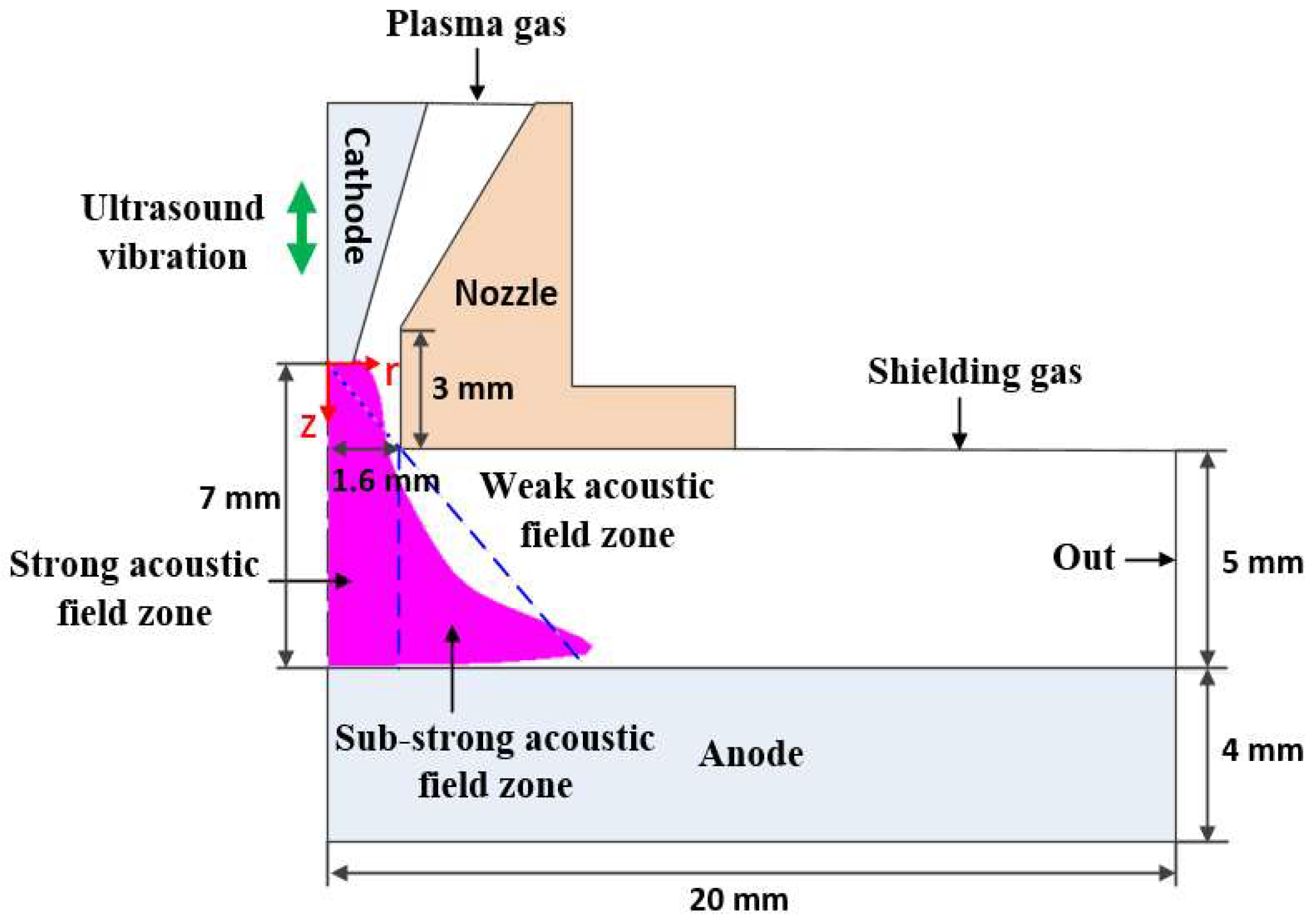
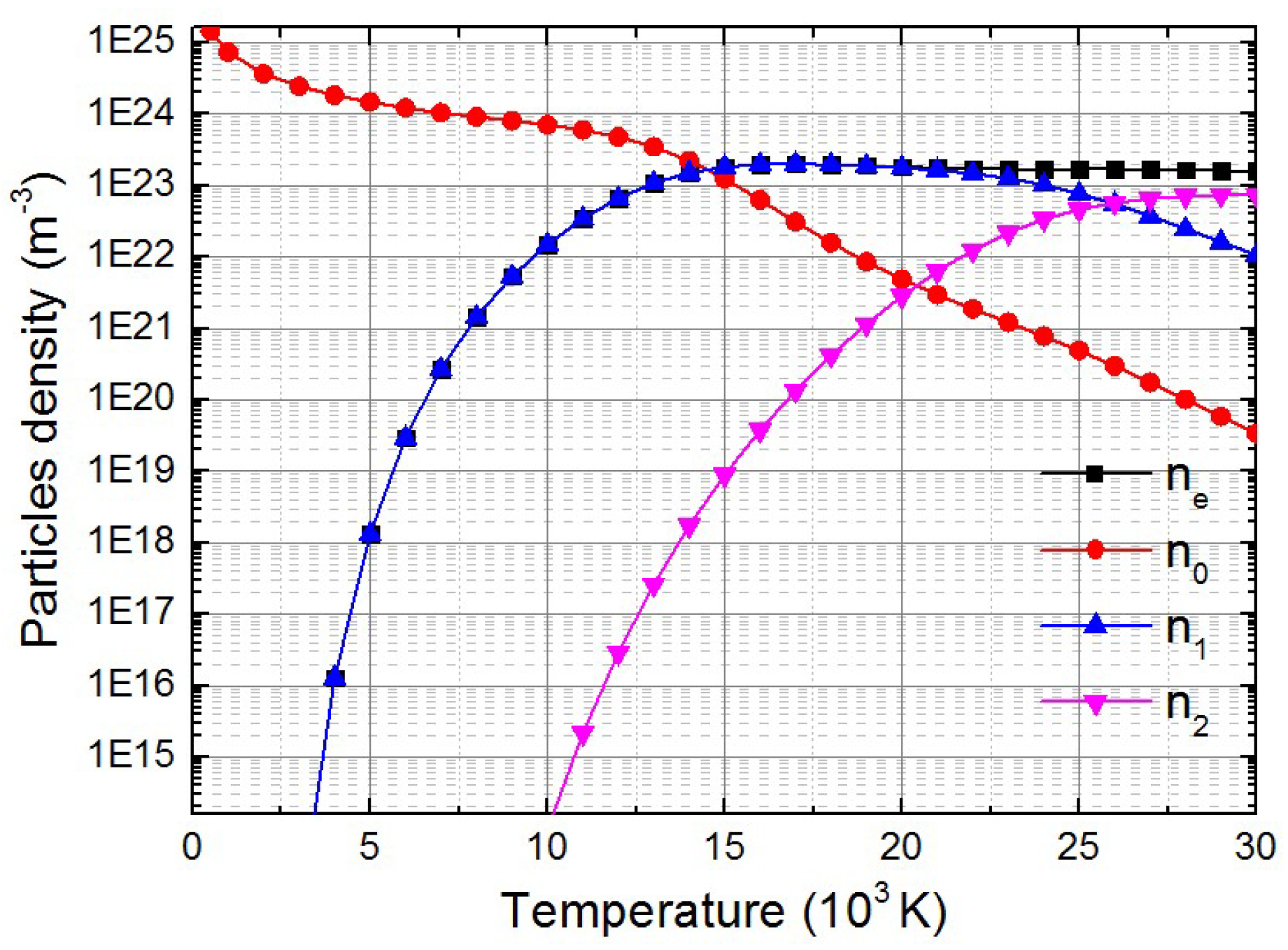
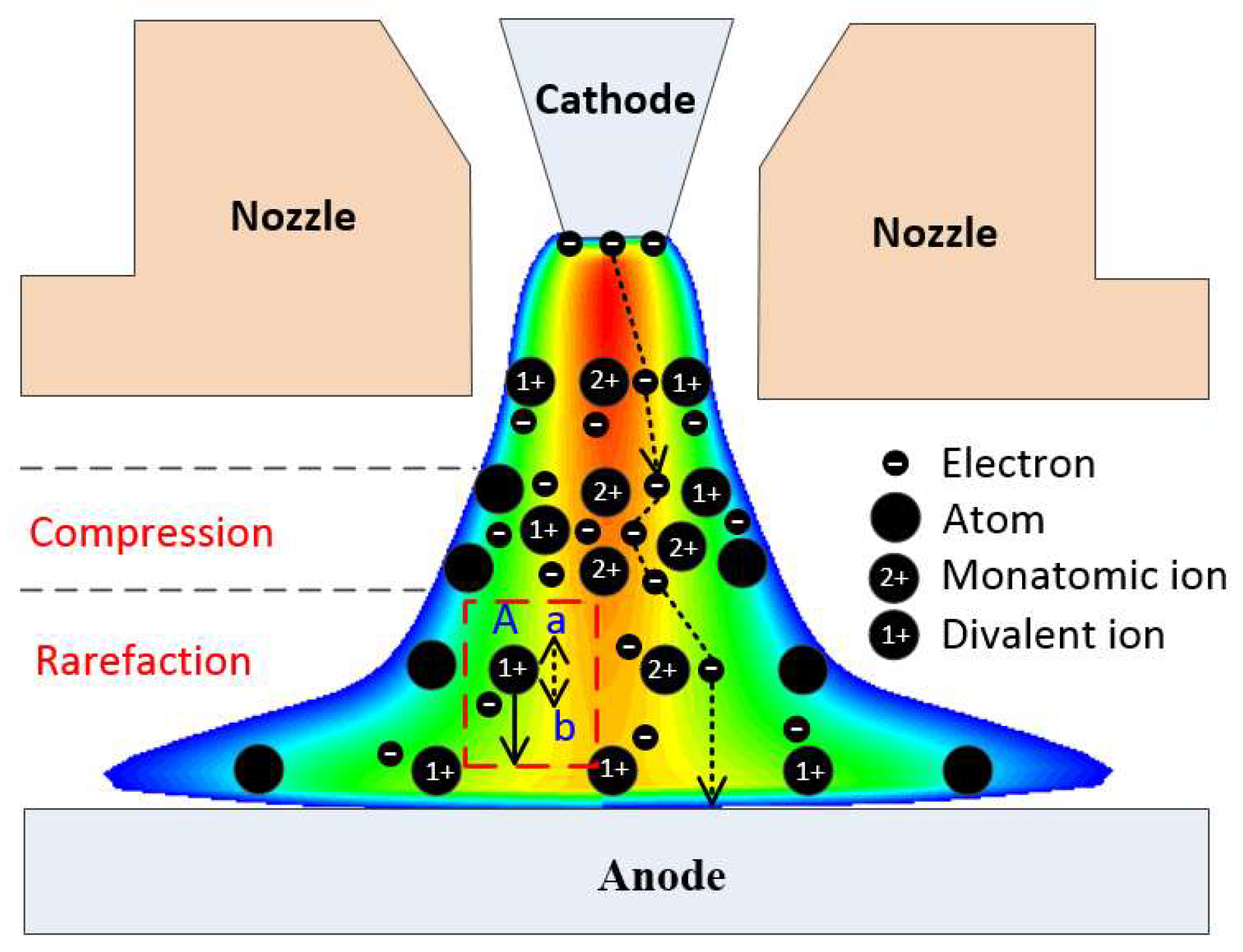

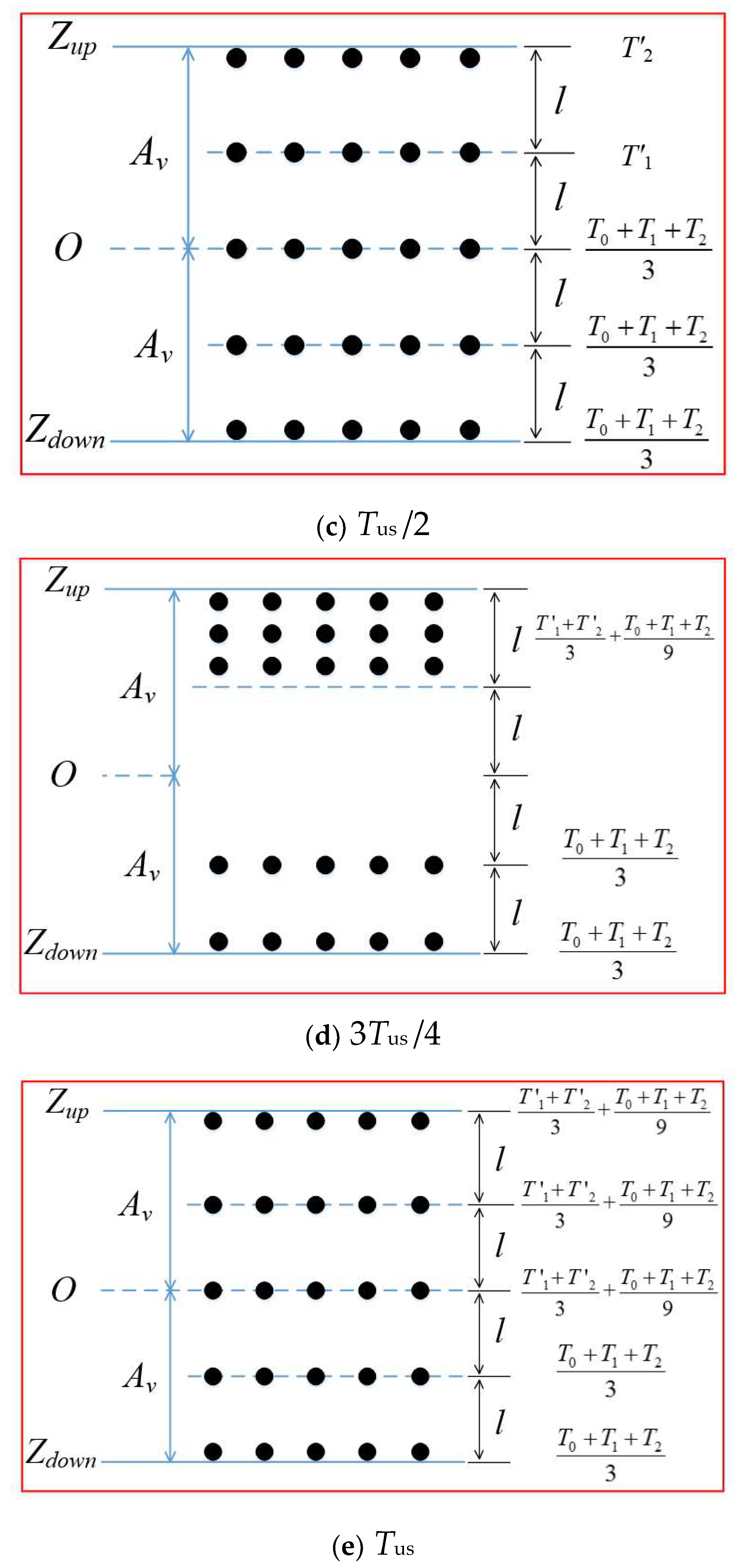

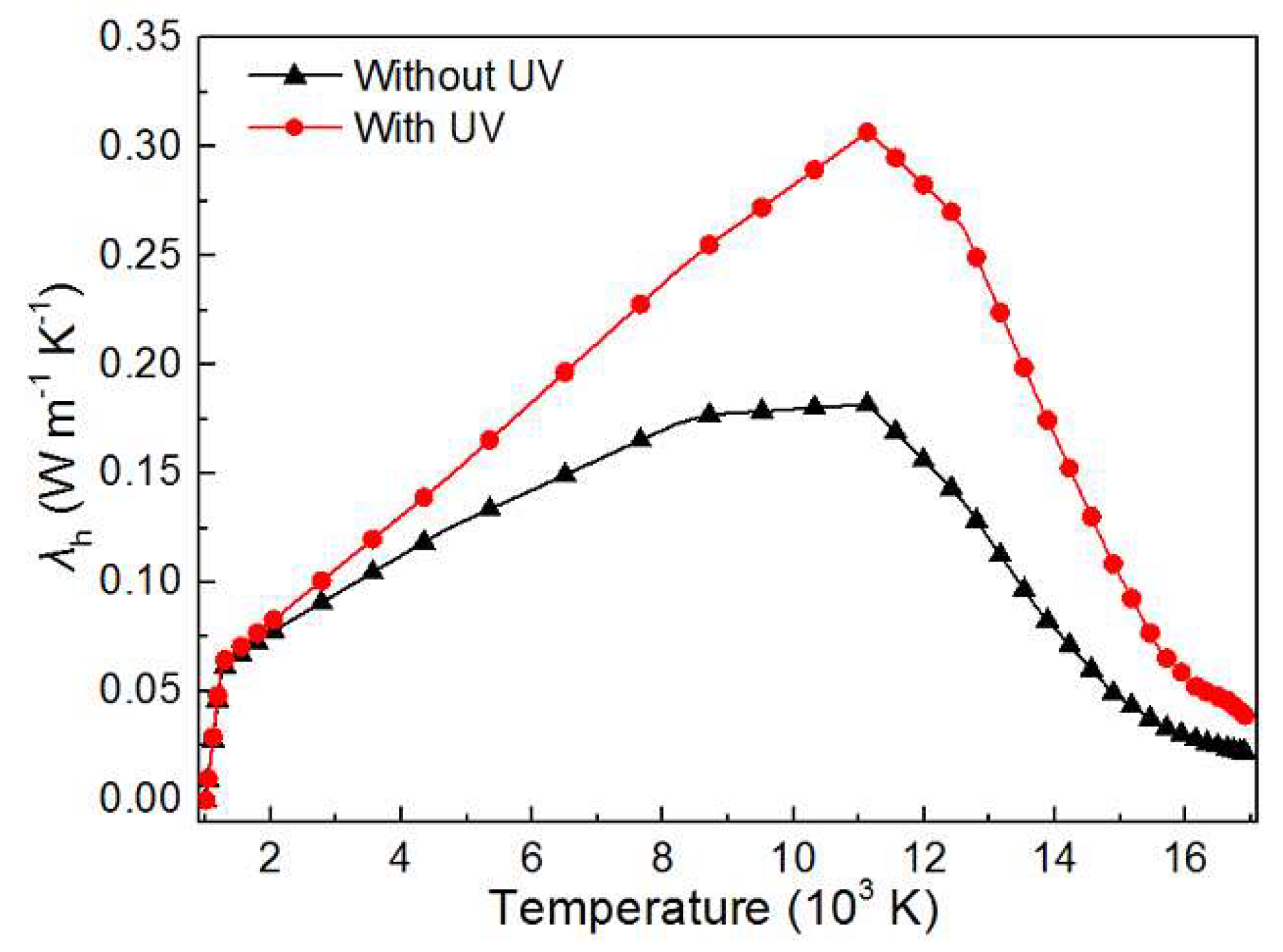
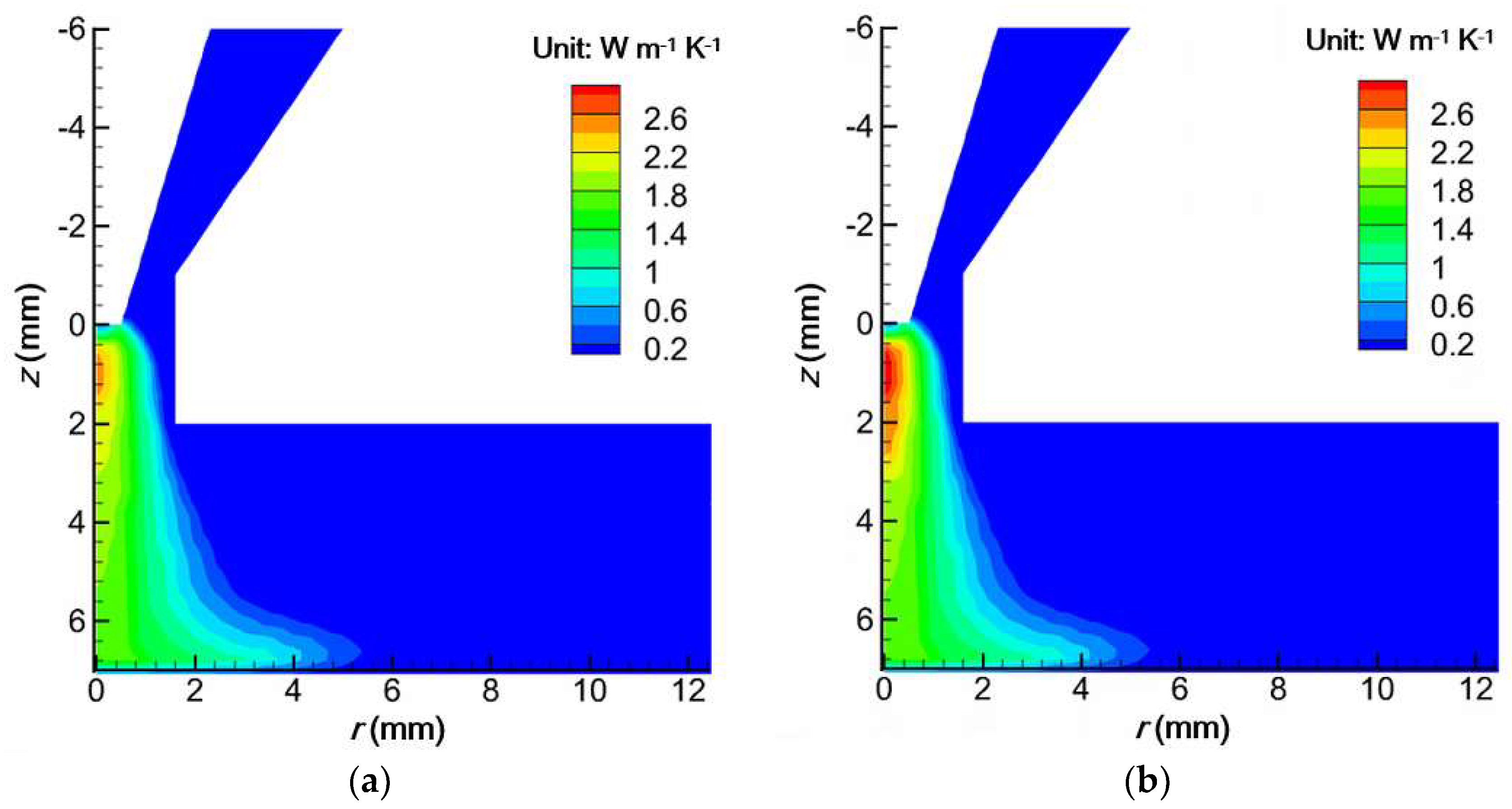
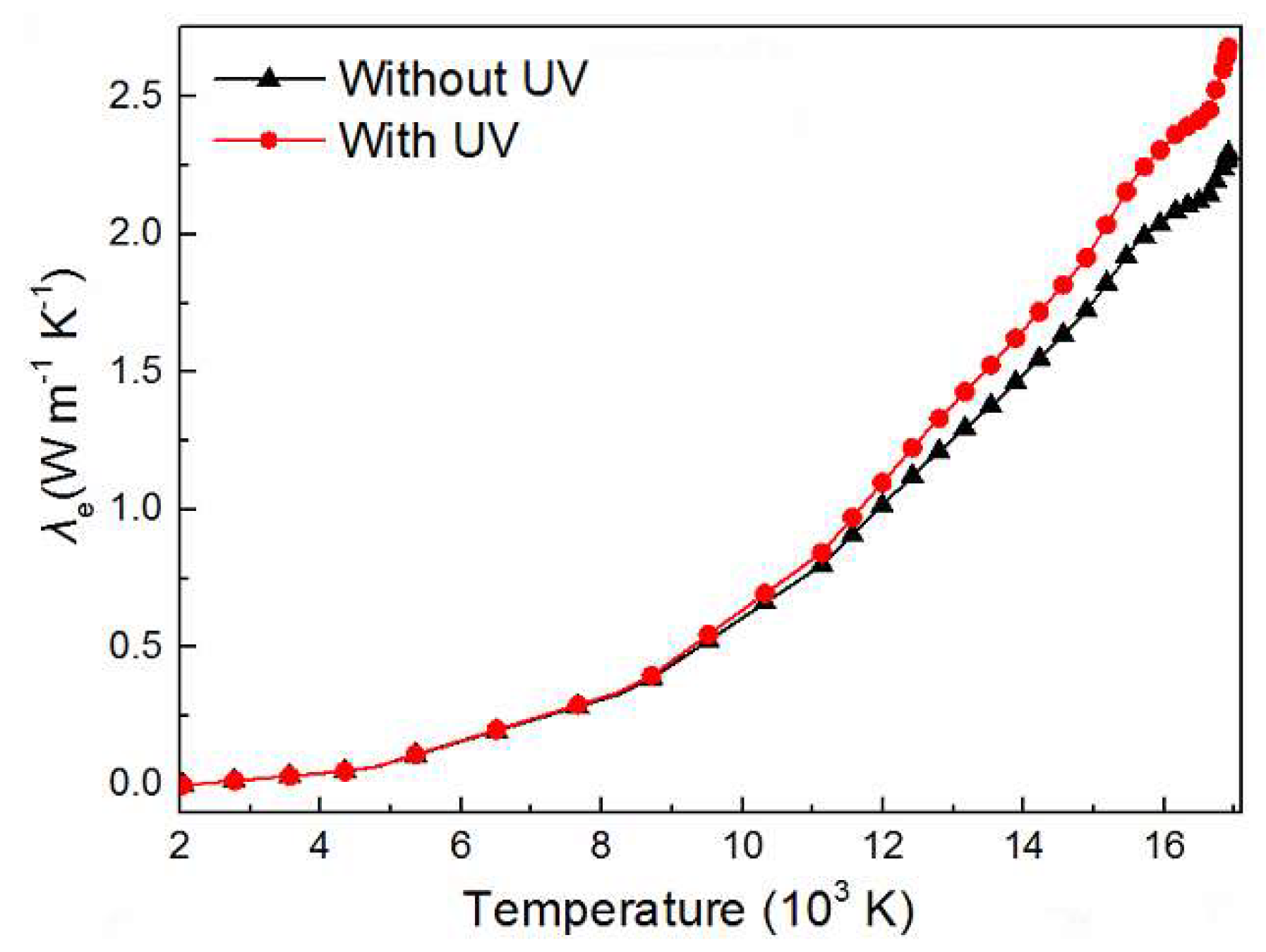
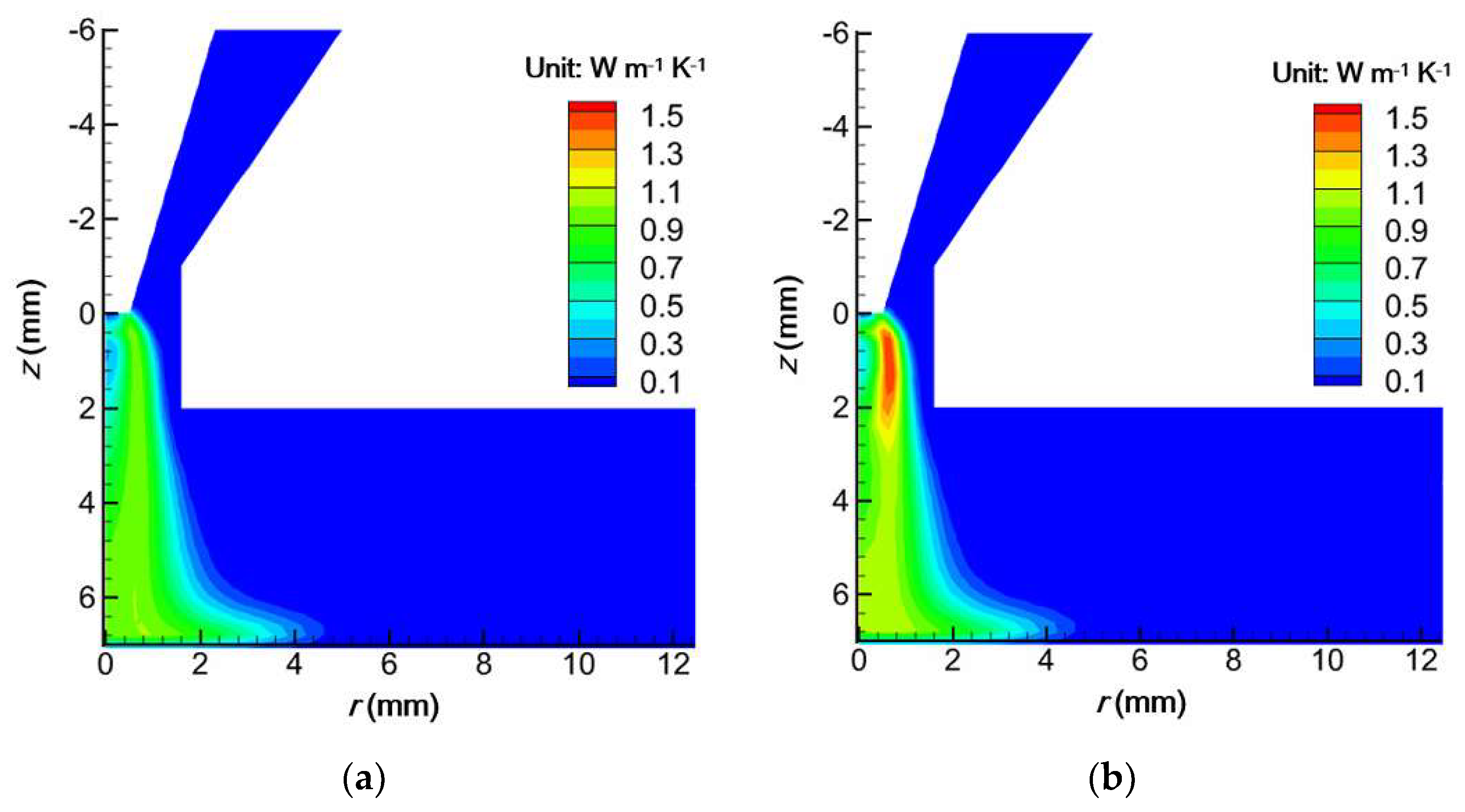
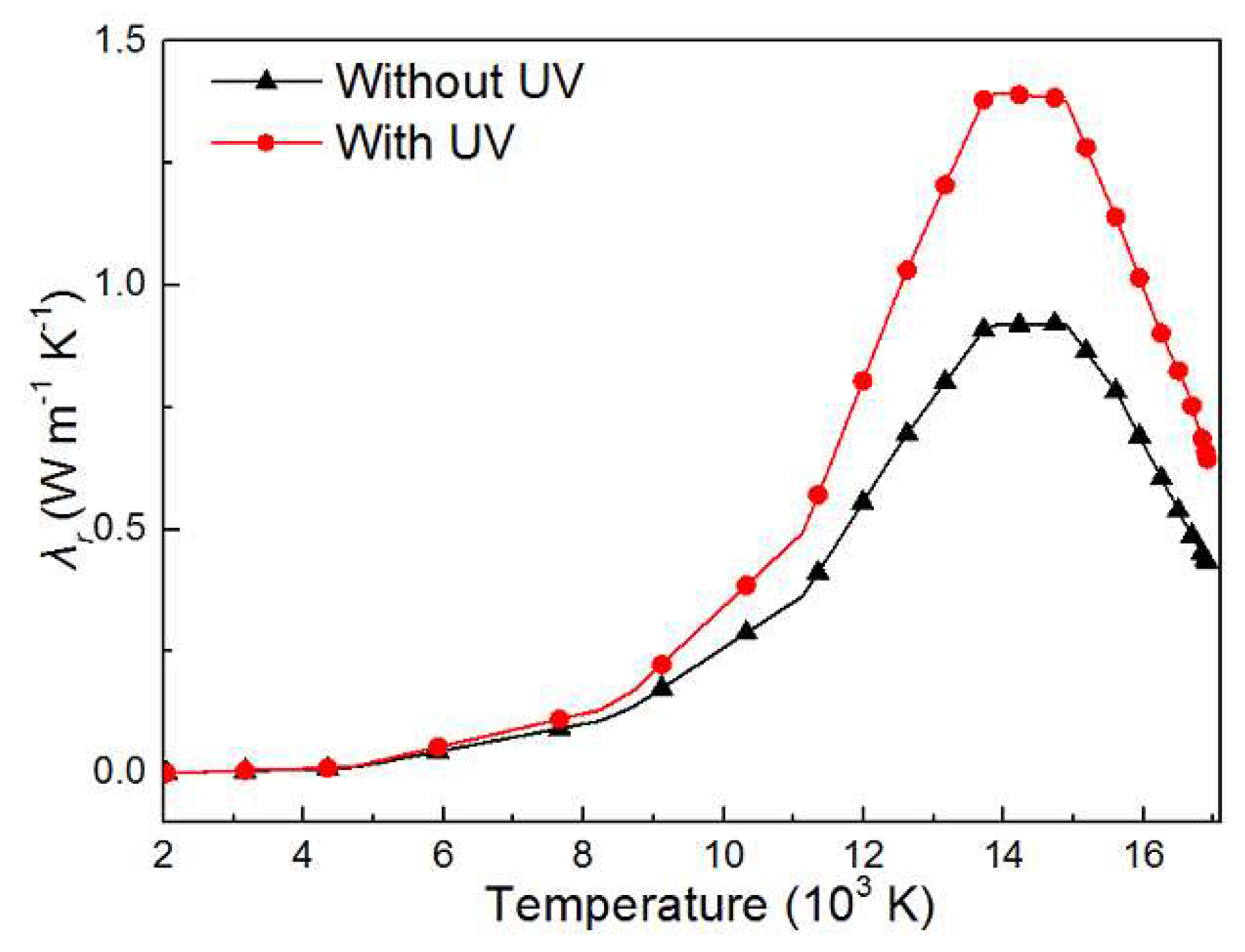
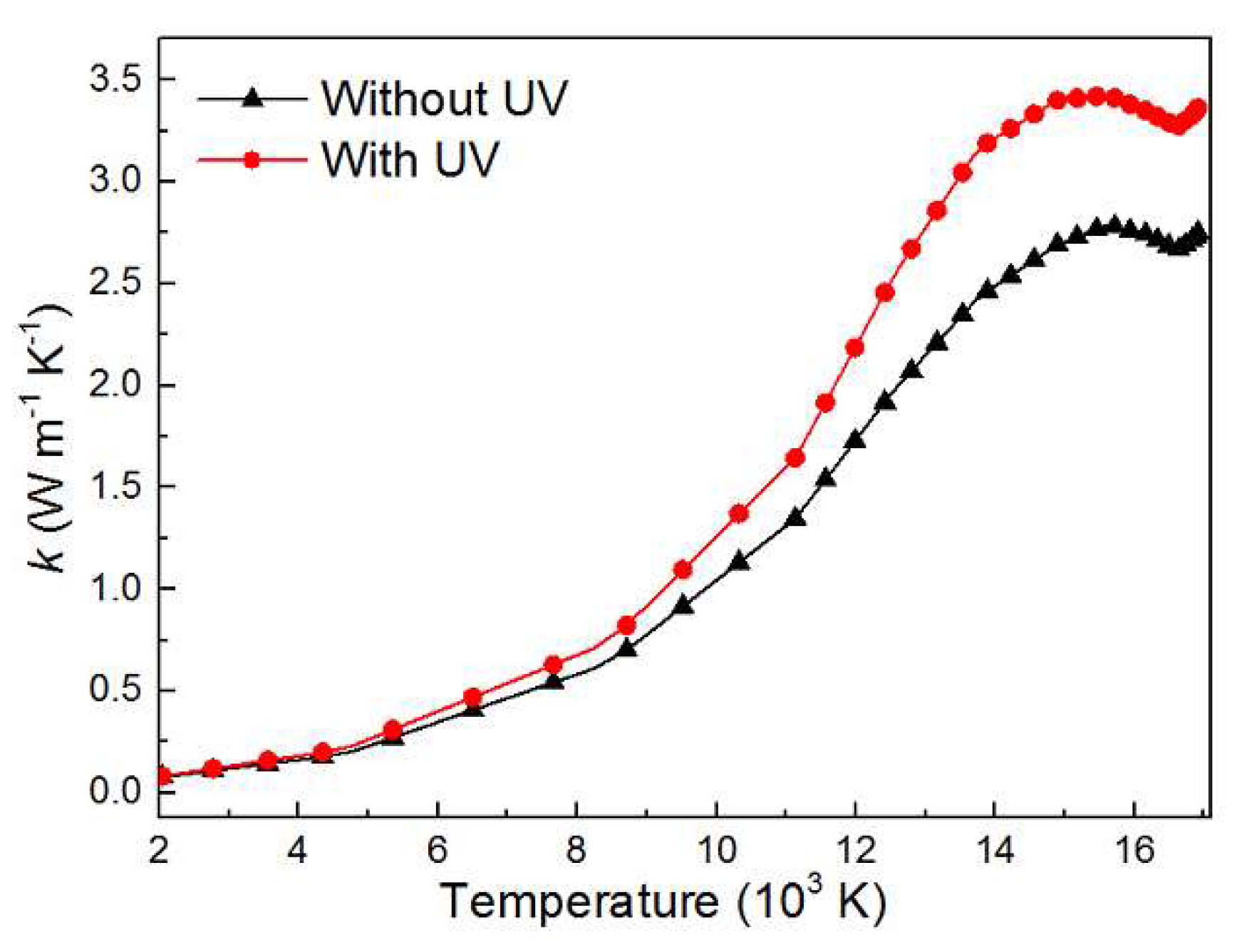
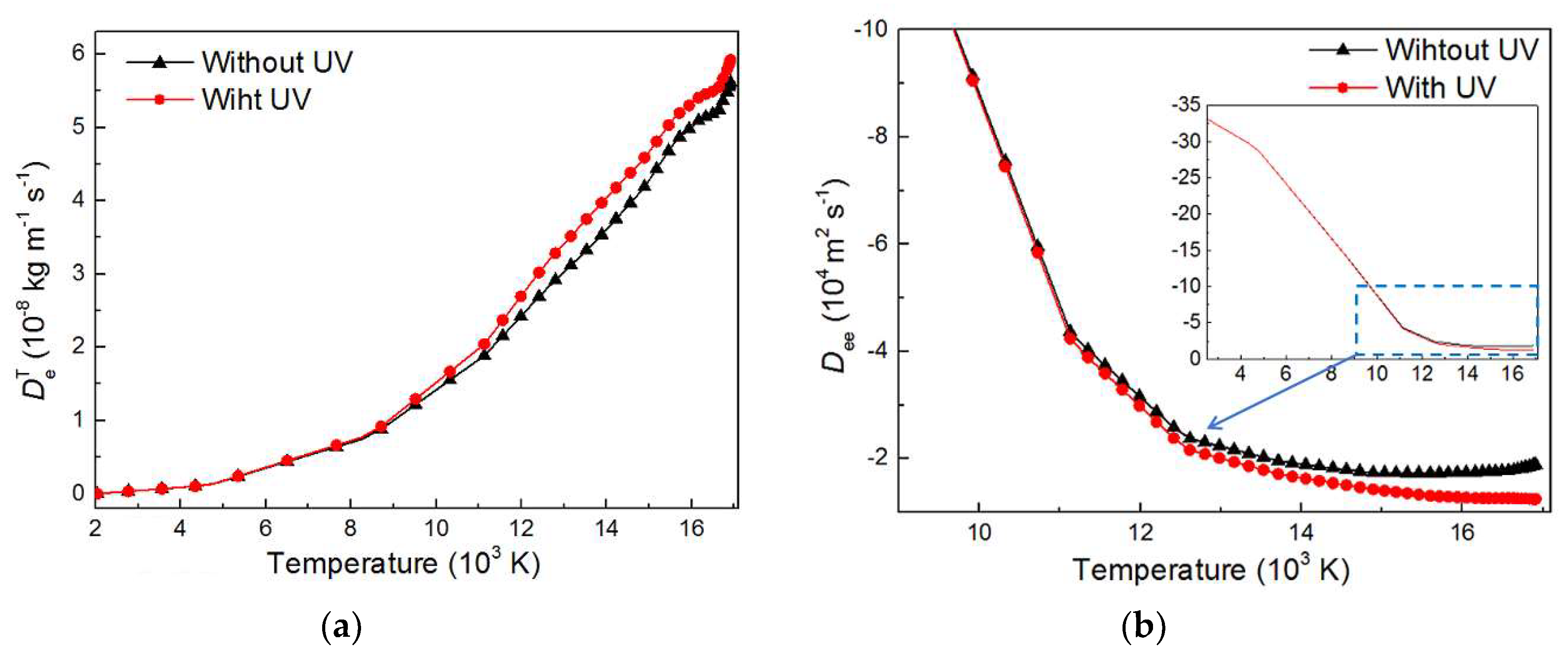

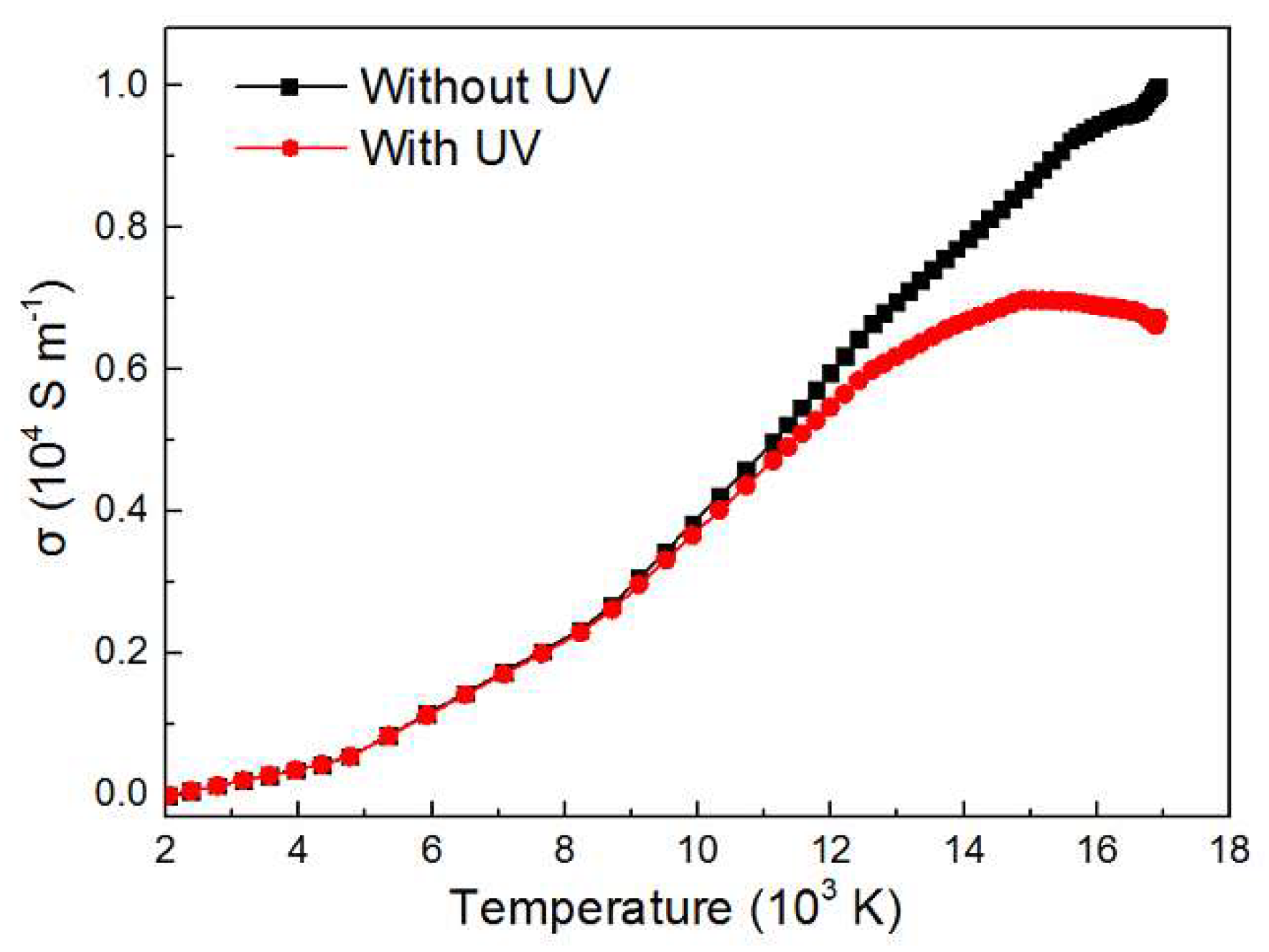
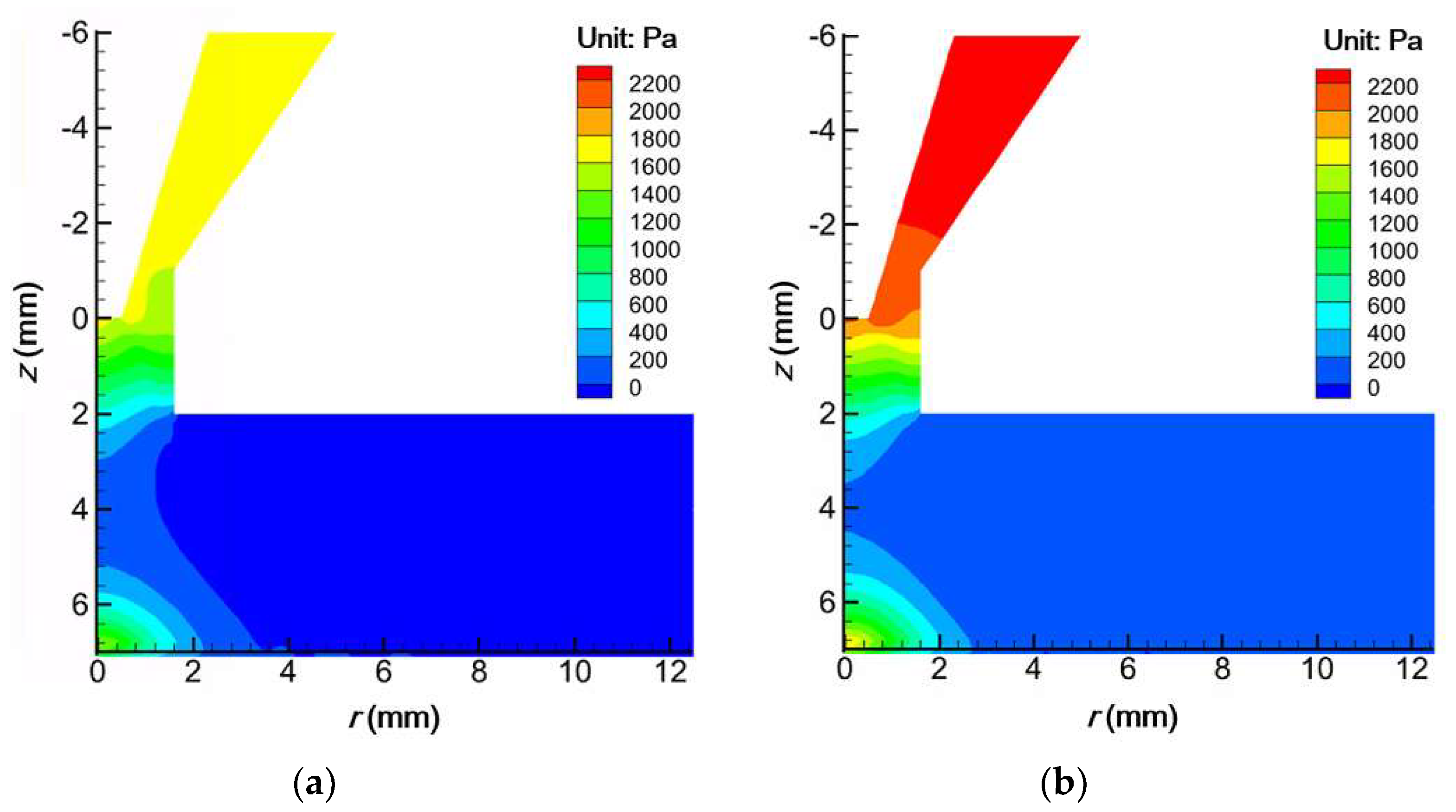
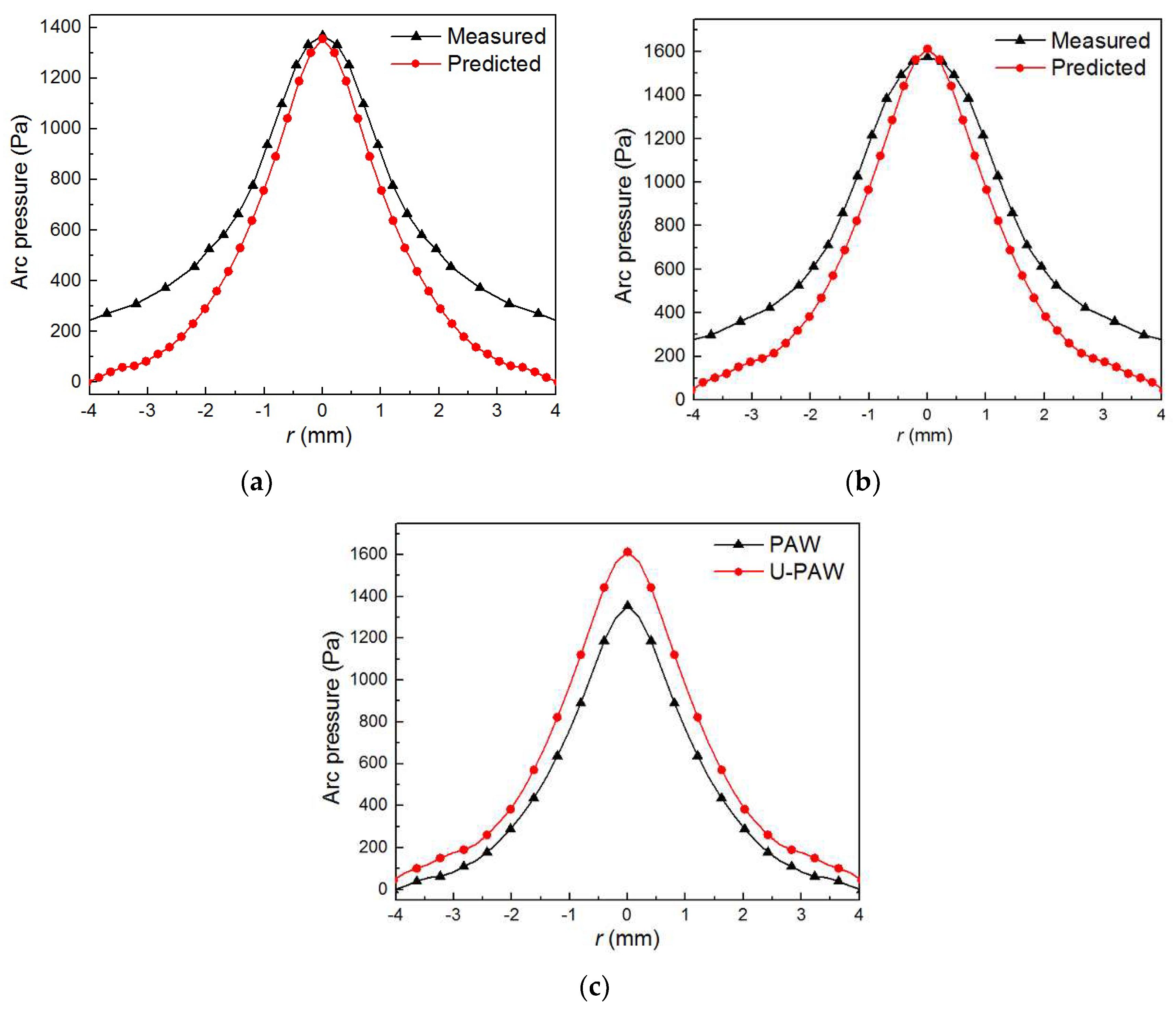
© 2020 by the authors. Licensee MDPI, Basel, Switzerland. This article is an open access article distributed under the terms and conditions of the Creative Commons Attribution (CC BY) license (http://creativecommons.org/licenses/by/4.0/).
Share and Cite
Li, Y.; Wu, C.; Chen, M. Effects of Ultrasonic Vibration on the Transport Coefficients in Plasma Arc Welding. Metals 2020, 10, 312. https://doi.org/10.3390/met10030312
Li Y, Wu C, Chen M. Effects of Ultrasonic Vibration on the Transport Coefficients in Plasma Arc Welding. Metals. 2020; 10(3):312. https://doi.org/10.3390/met10030312
Chicago/Turabian StyleLi, Yongfeng, Chuansong Wu, and Maoai Chen. 2020. "Effects of Ultrasonic Vibration on the Transport Coefficients in Plasma Arc Welding" Metals 10, no. 3: 312. https://doi.org/10.3390/met10030312




